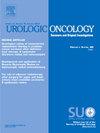肾细胞癌的细胞外囊泡:现状和未来方向的回顾。
IF 2.4
3区 医学
Q3 ONCOLOGY
Urologic Oncology-seminars and Original Investigations
Pub Date : 2025-03-10
DOI:10.1016/j.urolonc.2025.02.022
引用次数: 0
摘要
液体活检是一种使用患者体液(如血液、尿液或唾液)的微创活检方法,被认为是早期诊断、监测肿瘤进展和评估治疗效果的有用生物标志物。细胞外囊泡(EVs)是一种从各种细胞中释放出来的液体双层结构,根据其大小和生物合成方法进行分类。电动汽车含有特定的信息,如DNA、RNA和来自释放细胞的蛋白质。因此,它们在液体活检中的应用引起了人们的注意。ev衍生的microRNAs (miRNAs)和长链非编码rna (lncRNAs)是癌症诊断、肿瘤进展和药物耐药的有用生物标志物。肾细胞癌(RCC)是泌尿系统最常见的癌症之一,占所有肾脏肿瘤的90%。与已经建立肿瘤标志物的前列腺癌不同,临床适用和有用的RCC生物标志物仍有待建立。ev衍生的mirna和lncrna已被确定为几种类型癌症的有用生物标志物,用于确定RCC患者的诊断和预测肿瘤进展以及药物耐药性。开发和鉴定用于诊断和预测RCC肿瘤进展的生物标志物将改善RCC患者的管理和预后。本文综述了ev衍生的mirna和lncrna,并讨论了目前在RCC中可用的ev生物标志物及其未来前景。本文章由计算机程序翻译,如有差异,请以英文原文为准。
Extracellular vesicles in renal cell carcinoma: A review of the current landscape and future directions
Liquid biopsy, a minimally invasive biopsy method that uses patient body fluids (e.g., blood, urine, or saliva), is considered a useful biomarker for early diagnosis, monitoring of tumor progression, and evaluating treatment efficacy. Extracellular vesicles (EVs), a diverse group of particles classified according to their size and biosynthetic method, are liquid bilayer structures released from various cells. EVs contain specific information, such as DNA, RNA, and proteins derived from released cells. Consequently, they have attracted attention for use in liquid biopsy. EV-derived microRNAs (miRNAs) and long noncoding RNAs (lncRNAs) are useful biomarkers for cancer diagnosis, tumor progression, and drug treatment resistance. Renal cell carcinoma (RCC), one of the most common type of urological cancer, accounts for 90% of all renal tumors. In contrast to prostate cancer, for which a tumor marker has been established, clinically applicable and useful biomarkers remain to be established for RCC. EV-derived miRNAs and lncRNAs have been identified as useful biomarkers in several types of carcinoma for determining the diagnosis and predicting tumor progression, and drug treatment resistance in patients with RCC. The development and identification of biomarkers to diagnose and predict tumor progression in RCC will improve the management and prognosis of patients with RCC. This review focuses on EV-derived miRNAs and lncRNAs and discusses the currently available EV-based biomarkers in RCC and their future prospects.
求助全文
通过发布文献求助,成功后即可免费获取论文全文。
去求助
来源期刊
CiteScore
4.80
自引率
3.70%
发文量
297
审稿时长
7.6 weeks
期刊介绍:
Urologic Oncology: Seminars and Original Investigations is the official journal of the Society of Urologic Oncology. The journal publishes practical, timely, and relevant clinical and basic science research articles which address any aspect of urologic oncology. Each issue comprises original research, news and topics, survey articles providing short commentaries on other important articles in the urologic oncology literature, and reviews including an in-depth Seminar examining a specific clinical dilemma. The journal periodically publishes supplement issues devoted to areas of current interest to the urologic oncology community. Articles published are of interest to researchers and the clinicians involved in the practice of urologic oncology including urologists, oncologists, and radiologists.

 求助内容:
求助内容: 应助结果提醒方式:
应助结果提醒方式:


